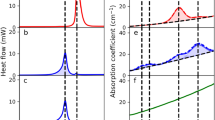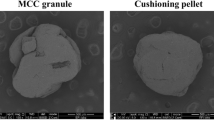Abstract
Purpose
To investigate the effect of compression on the crystallization behavior in amorphous tablets using sum frequency generation (SFG) microscopy imaging and more established analytical methods.
Method
Tablets containing neat amorphous griseofulvin with/without excipients (silica, hydroxypropyl methylcellulose acetate succinate (HPMCAS), microcrystalline cellulose (MCC) and polyethylene glycol (PEG)) were prepared. They were analyzed upon preparation and storage using attenuated total reflectance Fourier transform infrared (ATR-FTIR) spectroscopy, scanning electron microscopy (SEM) and SFG microscopy.
Results
Compression-induced crystallization occurred predominantly on the surface of the neat amorphous griseofulvin tablets, with minimal crystallinity being detected in the core of the tablets. The presence of various types of excipients was not able to mitigate the compression-induced surface crystallization of the amorphous griseofulvin tablets. However, the excipients affected the crystallization rate of amorphous griseofulvin in the core of the tablet upon compression and storage.
Conclusions
SFG microscopy can be used in combination with ATR-FTIR spectroscopy and SEM to understand the crystallization behaviour of amorphous tablets upon compression and storage. When selecting excipients for amorphous formulations, it is important to consider the effect of the excipients on the physical stability of the amorphous formulations.








Similar content being viewed by others
Abbreviations
- ATR-FTIR:
-
Attenuated total reflectance Fourier transform infrared
- DSC:
-
Differential scanning calorimetry
- HPMCAS:
-
Hydroxypropyl methylcellulose acetate succinate
- HyD:
-
Hybrid detector
- IR:
-
Infrared
- MCC:
-
Microcrystalline cellulose
- NMR:
-
Nuclear magnetic resonance
- OPO:
-
Optical parametric oscillator
- PEG:
-
Polyethylene glycol
- PMT:
-
Photomultiplier tube
- SEM:
-
Scanning electron microscopy
- SFG:
-
Sum frequency generation
- SHG:
-
Second harmonic generation
- XRPD:
-
X-ray powder diffractometry
REFERENCES
Lipinski CA. Drug-like properties and the causes of poor solubility and poor permeability. J Pharmacol Toxicol Methods. 2000;44(1):235–49.
Lipinski CA, Lombardo F, Dominy BW, Feeney PJ. Experimental and computational approaches to estimate solubility and permeability in drug discovery and development settings. Advanced Drug Deliv Rev. 2012;64, Supplement:4–17.
Elder DP, Holm R, Diego HL. Use of pharmaceutical salts and cocrystals to address the issue of poor solubility. Int J Pharm. 2013;453(1):88–100.
Kurkov SV, Loftsson T. Cyclodextrins. Int J Pharm. 2013;453(1):167–80.
Lu Y, Park K. Polymeric micelles and alternative nanonized delivery vehicles for poorly soluble drugs. Int J Pharm. 2013;453(1):198–214.
Möschwitzer JP. Drug nanocrystals in the commercial pharmaceutical development process. Int J Pharm. 2013;453(1):142–56.
Mu H, Holm R, Müllertz A. Lipid-based formulations for oral administration of poorly water-soluble drugs. Int J Pharm. 2013;453(1):215–24.
Kawakami K. Current status of amorphous formulation and other special dosage forms as formulations for early clinical phases. J Pharm Sci. 2009;98(9):2875–85.
Babu NJ, Nangia A. Solubility advantage of amorphous drugs and pharmaceutical cocrystals. Cryst Growth Des. 2011;11(7):2662–79.
Laitinen R, Löbmann K, Strachan CJ, Grohganz H, Rades T. Emerging trends in the stabilization of amorphous drugs. Int J Pharm. 2013;453(1):65–79.
Hancock BC, Zografi G. Characteristics and significance of the amorphous state in pharmaceutical systems. J Pharm Sci. 1997;86(1):1–12.
Yu L. Amorphous pharmaceutical solids: preparation, characterization and stabilization. Adv Drug Deliv Rev. 2001;48(1):27–42.
Ayenew Z, Paudel A, Rombaut P, Mooter G. Effect of compression on non-isothermal crystallization behaviour of amorphous indomethacin. Pharm Res. 2012;29(9):2489–98.
Thakral NK, Mohapatra S, Stephenson GA, Suryanarayanan R. Compression-induced crystallization of amorphous indomethacin in tablets: characterization of spatial heterogeneity by two-dimensional X-ray diffractometry. Mol Pharm. 2015;12(1):253–63.
Shah B, Kakumanu VK, Bansal AK. Analytical techniques for quantification of amorphous/crystalline phases in pharmaceutical solids. J Pharm Sci. 2006;95(8):1641–65.
Chieng N, Rades T, Aaltonen J. An overview of recent studies on the analysis of pharmaceutical polymorphs. J Pharm Biomed Anal. 2011;55(4):618–44.
Widjaja E, Kanaujia P, Lau G, Ng WK, Garland M, Saal C, et al. Detection of trace crystallinity in an amorphous system using Raman microscopy and chemometric analysis. Eur J Pharm Sci. 2011;42(1–2):45–54.
Kanaujia P, Lau G, Ng WK, Widjaja E, Schreyer M, Hanefeld A, et al. Investigating the effect of moisture protection on solid-state stability and dissolution of fenofibrate and ketoconazole solid dispersions using PXRD, HSDSC and Raman microscopy. Drug Dev Ind Pharm. 2011;37(9):1026–35.
Lee CJ, Strachan CJ, Manson PJ, Rades T. Characterization of the bulk properties of pharmaceutical solids using nonlinear optics - a review. J Pharm Pharmacol. 2007;59(2):241–50.
Schneider L, Peukert W. Second harmonic generation spectroscopy as a method for in situ and online characterization of particle surface properties. Part Part Syst Charact. 2006;23(5):351–9.
Strachan CJ, Windbergs M, Offerhaus HL. Pharmaceutical applications of non-linear imaging. Int J Pharm. 2011;417(1–2):163–72.
Shen Y. Surface properties probed by second-harmonic and sum-frequency generation. Nature. 1989;337:519–25.
Zumbusch A, Holtom GR, Xie XS. Three-dimensional vibrational imaging by coherent anti-Stokes Raman scattering. Phys Rev Lett. 1999;82(20):4142.
Strachan CJ, Lee CJ, Rades T. Partial characterization of different mixtures of solids by measuring the optical nonlinear response. J Pharm Sci. 2004;93(3):733–42.
Chowdhury AU, Zhang S, Simpson GJ. Powders analysis by second harmonic generation microscopy. Anal Chem. 2016;88(7):3853–63.
Schmitt PD, Trasi NS, Taylor LS, Simpson GJ. Finding the needle in the haystack: characterization of trace crystallinity in a commercial formulation of paclitaxel protein-bound particles by Raman spectroscopy enabled by second harmonic generation microscopy. Mol Pharm. 2015;12(7):2378–83.
Zhu Q, Harris MT, Taylor LS. Modification of crystallization behavior in drug/polyethylene glycol solid dispersions. Mol Pharm. 2012;9(3):546–53.
Zhu Q, Toth SJ, Simpson GJ, Hsu H-Y, Taylor LS, Harris MT. Crystallization and dissolution behavior of naproxen/polyethylene glycol solid dispersions. J Phys Chem B. 2013;117(5):1494–500.
Wanapun D, Kestur US, Kissick DJ, Simpson GJ, Taylor LS. Selective detection and quantitation of organic molecule crystallization by second harmonic generation microscopy. Anal Chem. 2010;82(13):5425–32.
Wanapun D, Kestur US, Taylor LS, Simpson GJ. Single particle nonlinear optical imaging of trace crystallinity in an organic powder. Anal Chem. 2011;83(12):4745–51.
Kestur US, Wanapun D, Toth SJ, Wegiel LA, Simpson GJ, Taylor LS. Nonlinear optical imaging for sensitive detection of crystals in bulk amorphous powders. J Pharm Sci. 2012;101(11):4201–13.
Hsu H-Y, Toth SJ, Simpson GJ, Taylor LS, Harris MT. Effect of substrates on naproxen-polyvinylpyrrolidone solid dispersions formed via the drop printing technique. J Pharm Sci. 2013;102(2):638–48.
Mahieu A, Willart J-F, Dudognon E, Eddleston MD, Jones W, Danède F, et al. On the polymorphism of griseofulvin: identification of two additional polymorphs. J Pharm Sci. 2013;102(2):462–8.
Pan Q, Guo P, Duan J, Cheng Q, Li H. Comparative crystal structure determination of griseofulvin: powder X-ray diffraction versus single-crystal X-ray diffraction. Chin Sci Bull. 2012;57(30):3867–71.
Zoumi A, Yeh A, Tromberg BJ. Imaging cells and extracellular matrix in vivo by using second-harmonic generation and two-photon excited fluorescence. Proc Natl Acad Sci. 2002;99(17):11014–9.
Gallais L, Douti D-B, Commandre M, Batavičiūtė G, Pupka E, Ščiuka M, et al. Wavelength dependence of femtosecond laser-induced damage threshold of optical materials. J Appl Phys. 2015;117(22):223103.
Watanabe T, Wakiyama N, Usui F, Ikeda M, Isobe T, Senna M. Stability of amorphous indomethacin compounded with silica. Int J Pharm. 2001;226(1–2):81–91.
Wang L, Cui FD, Sunada H. Preparation and evaluation of solid dispersions of nitrendipine prepared with fine silica particles using the melt-mixing method. Chem Pharm Bull. 2006;54(1):37–43.
Hellrup J, Alderborn G, Mahlin D. Inhibition of recrystallization of amorphous lactose in nanocomposites formed by spray-drying. J Pharm Sci. 2015;104(11):3760–9.
Ellison CD, Ennis BJ, Hamad ML, Lyon RC. Measuring the distribution of density and tabletting force in pharmaceutical tablets by chemical imaging. J Pharm Biomed Anal. 2008;48(1):1–7.
De Figueiredo LP, Ferreira FF. The Rietveld method as a tool to quantify the amorphous amount of microcrystalline cellulose. J Pharm Sci. 2014;103(5):1394–9.
Takahashi Y, Tadokoro H. Structural studies of polyethers,(−(CH2)mO-)n. X. Crystal structure of poly (ethylene oxide). Macromolecules. 1973;6(5):672–5.
Pielichowska K, Głowinkowski S, Lekki J, Biniaś D, Pielichowski K, Jenczyk J. PEO/fatty acid blends for thermal energy storage materials. Structural/morphological features and hydrogen interactions. Eur Polym J. 2008;44(10):3344–60.
ACKNOWLEDGMENTS AND DISCLOSURES
This study was partially supported by the Pharmacy Grant 2013 (University of Helsinki). Elman Poole Travelling Fellowship and the University of Otago Doctoral Scholarship are gratefully acknowledged for providing Pei Ting Mah with financial support. Timo Laaksonen acknowledges funding from the Academy of Finland grant no. 258114.
Author information
Authors and Affiliations
Corresponding author
Additional information
Dunja Novakovic and Jukka Saarinen contributed equally to this work.
Electronic supplementary material
Below is the link to the electronic supplementary material.
ESM 1
(DOCX 653 kb)
Rights and permissions
About this article
Cite this article
Mah, P.T., Novakovic, D., Saarinen, J. et al. Elucidation of Compression-Induced Surface Crystallization in Amorphous Tablets Using Sum Frequency Generation (SFG) Microscopy. Pharm Res 34, 957–970 (2017). https://doi.org/10.1007/s11095-016-2046-6
Received:
Accepted:
Published:
Issue Date:
DOI: https://doi.org/10.1007/s11095-016-2046-6




